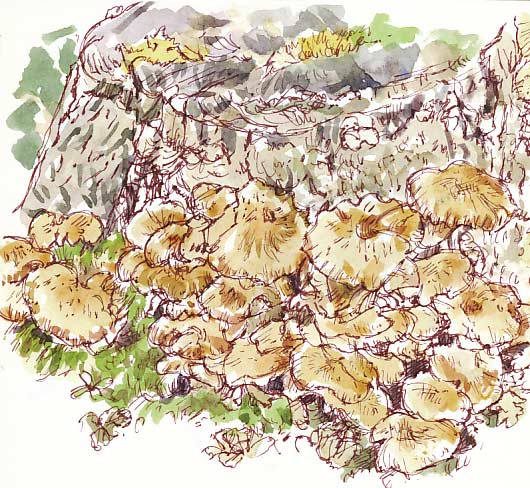 Honey Fungus
Honey Fungus Honey Fungus
Honey FungusWild West Yorkshire, Saturday 16 October 2010
previous | this month | next
WHEN I SKETCHED this ash stump back in April (12 April 2010), only bracket fungus was visible. It's now been taken over by honey fungus. One characteristic of this fungus is that timber in which its mycelium is active glows in the dark. I've read that pieces of timber infected by the fungus were used to mark the edges of paths so that travellers could find their way through the forest on dark, moonless nights. I've never observed this for myself but at Halloween if Barbara's mum phones us and tells us that she's seen a glowing apparition in her back garden, we'll know it's this ash stump.
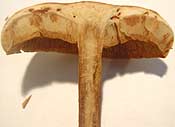
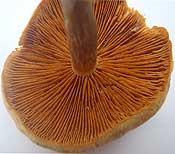 A network of strands of mycelium forms the main body of the fungus in the log while the toadstools are the equivalent of its fruiting bodies. Honey fungus is also now showing in little groups on the wood chip paths in our back garden. I cut this one in half to show the structure of the gills, then left the cap, gills downwards, on a piece of paper overnight, covered by a cup so that it wasn't disturbed by any draughts.
A network of strands of mycelium forms the main body of the fungus in the log while the toadstools are the equivalent of its fruiting bodies. Honey fungus is also now showing in little groups on the wood chip paths in our back garden. I cut this one in half to show the structure of the gills, then left the cap, gills downwards, on a piece of paper overnight, covered by a cup so that it wasn't disturbed by any draughts.
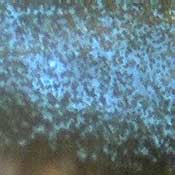
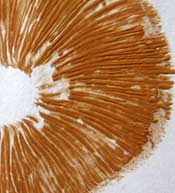
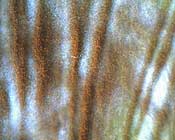 Spore Print
Spore PrintEven at 200 magnification (left), I couldn't make out the shape of individual spores but you get an impresson on the lower power images (right) of the quantities of spores that one cap can release overnight; it must run into millions.
"Browsing through your Wild Yorkshire web pages," writes Michael Oates ,"I couldn't help but notice what apears to be a decidedly brown spore print for what is suggested as Honey Fungus, or Amanita (which is edible). However, Honey Fungus differs in several respects from what is illustrated...The gills and spore print should be white and there should be a ring around the stalk. The one from your photos looks more like the similar Galerina, (which is very poisonous).
"I have a large garden riddled with Honey Fungus. The trees and shrubs are suffering badly, but at least each October we get a delicious fungi feast.
"Just thought i should mention this as someone may see the description, be confused and eat the wrong one!"
Many thanks, Michael!
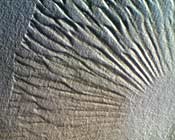
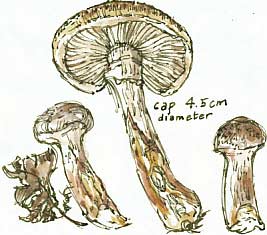
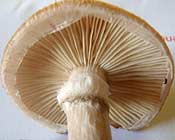 Stump Toadstool
Stump ToadstoolAlso growing on the stump were a few of these smaller toadstools. You can see that as it grows the cap starts out club-shaped then as it opens out it leaves a ring on the stipe (stem) of the fungus. The spore print revealed that it has white spores.
 Drawing at Dawn
Drawing at Dawn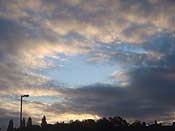 INSPIRED by the opening chapter on weather and sky in Chris Packham's Nature Handbook, I took a photograph of this morning's sunrise to draw over breakfast at Barbara's mum's from the LED display screen of my camera.
INSPIRED by the opening chapter on weather and sky in Chris Packham's Nature Handbook, I took a photograph of this morning's sunrise to draw over breakfast at Barbara's mum's from the LED display screen of my camera.
From the Handbook I can tell you that those clouds are stratocumulus. The book is full of lots of simple - and a few more ambitious - suggestions for getting out and seeing the natural world all around you and, as it's so easy to forget, above you. Even in the middle of a city you can usually find a patch of sky but in woodland too, it's always worth looking up at the tree canopy.
I soon decided that the LED screen was rather small for me to draw from (I do need an iPad, don't I?!) so I went out to draw the honey fungus on the ash stump.
Why draw from a little screen when you can draw real live nature?
'Real wildlife . . . will enrich your life', says Packham in his introduction; he tells us that he'd 'rather spend ten minutes watching a woodlouse or ladybird in the palm of [his] hand than ten minutes watching a tiger on TV.'
He insists that there shouldn't be any 'dumbing down' when it comes to exploring the workings of the natural world. For 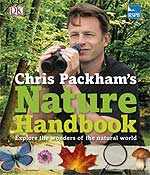 example, he never uses the term 'mini-beasts' to describe invertebrates to children - which is something I must admit that I did when Barbara and I helped run a Wildlife Watch group twenty years ago; it was part of the 'house style' of Watch in those days, I suppose that 'mini-beasts' was supposed to sound more fun than 'invertebrates'. As Packham says, you have to wonder why we shy away from teaching children a proper naturalist's vocabulary when they so easily and ably enjoy the names of dinosaurs.
example, he never uses the term 'mini-beasts' to describe invertebrates to children - which is something I must admit that I did when Barbara and I helped run a Wildlife Watch group twenty years ago; it was part of the 'house style' of Watch in those days, I suppose that 'mini-beasts' was supposed to sound more fun than 'invertebrates'. As Packham says, you have to wonder why we shy away from teaching children a proper naturalist's vocabulary when they so easily and ably enjoy the names of dinosaurs.
The book encourages you to take a fresh look at any habitat you find yourself in, starting with the sky and home and going as far afield as the chapperal and tropical rainforest. I might never get to visit the latter but this attractive book makes me I realise how lucky I am to be within 2 hours drive of examples of a huge variety of habitats on coasts, hills, heaths, lakes, rivers and streams. The book is delightfully designed, fresh-looking - Dorling Kindersley at its best - and it's been a timely inspiration for me.
Note: since I wrote the above, the father of one of our Wildlife Watch group children popped into the bookshop where Barbara works. He told her that son is now head of biology at a private school, so it seems that his time in the group helped inspired his choice of career years later . . . and evidently he managed to get over any confusion caused by our use of the term 'mini-beast'!
Because of our errand to Barbara's mum's, I didn't get the chance today to join my friends Helen Thomas and John Welding on our local leg of International SketchCrawl Day in Wakefield, so the log will have to be my contribution to the event. I enjoyed the sketchcrawl in Sheffield three weeks ago, and before that drawing at the Animated Yorkshire workshop at the Ponderosa zoo park and gatecrashing Matthew Palmer's watercolour class at picturesque Runswick Bay but - especially with all the worry and responsibilities we have over Barbara's mum's illness at present - I realise that I need to be on a daily sketchcrawl, finding somewhere that stimulates my curiosity and imagination.
Chris Packham's book emphasises, not that I needed much persuasion, that my personal ongoing sketchcrawl has to be based in the natural world. Perhaps you're familiar with thet stage that I always find myself in on a city sketchcrawl, when you find yourself wondering if you can be bothered to draw the salt and pepper pot on the cafe table, a subject you've drawn a hundred times before?
Well, you never get that with the natural world, especially if you make a point of exploring the wide variety of habitats that Packham encourages us to visit within easy access of home. There's always something extraordinary and unfamiliar to draw. Just riffle through the Nature Handbook - or like me, read it cover to cover, as a refresher course in natural history - and you'll get the hang of what to look for wherever you are.
Links: Take a look at today's sketchCrawl at Wakefield Sketch or join your next local Sketchcrawl at Sketchcrawl.com
Richard Bell, illustrator
previous | this month | Wild West Yorkshire home page | next